Sarasota History With Jeff LaHurd: City of Sarasota grew under Mayor Everett Bacon
- Oops!Something went wrong.Please try again later.
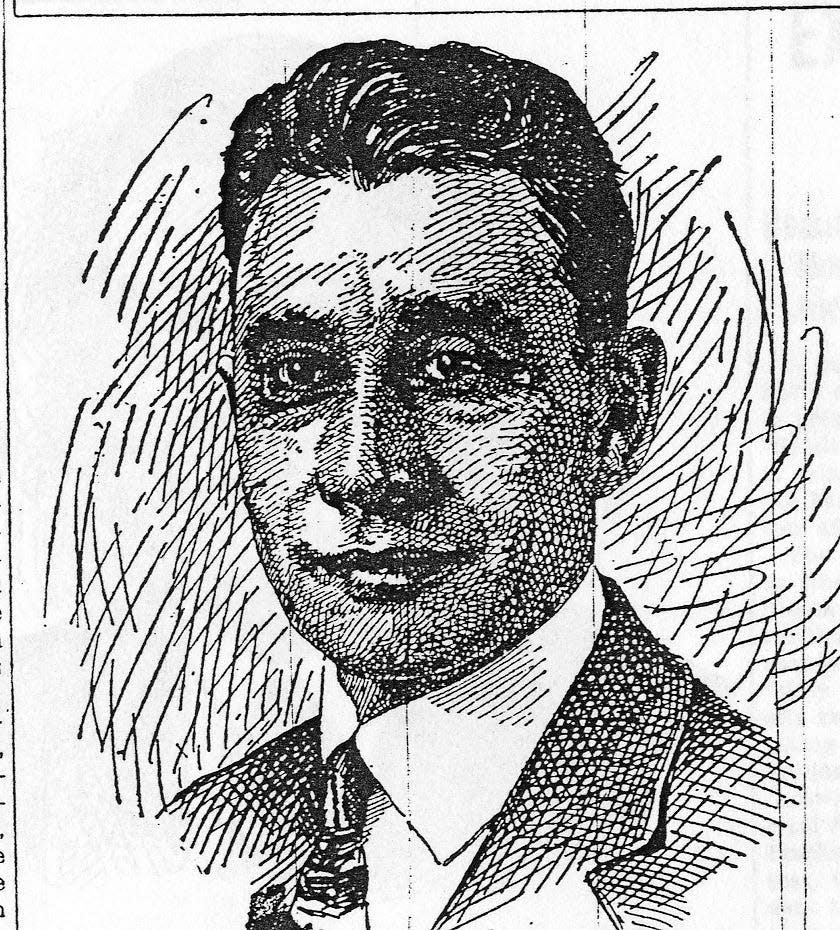
The face of Sarasota throughout the growth spurt of the frenetic Roaring ’20s was Everett Bacon, who was elected mayor five consecutive times.
Throughout the era, he was seen everywhere as he negotiated contracts, gave speeches, spoke at various civic groups, hosted important personages, cut ribbons at grand openings, and was often interviewed by the local newspapers as he lobbied for or against important proposals. During his tenure, the city quickly tripled in size.
By the time he left office, Sarasota could no longer be mistaken for a fishing/agricultural backwater. It had transformed into the go-to place for the monied snowbirds sought after throughout Florida.
Sarasota History With Jeff LaHurd: Golden past, dubious future for Mira Mar Apartments
Sarasota History With Jeff LaHurd: Hover Arcade was high point of bayfront development
Born in Williamsfield, Ohio – “North of the Mason Dixon Line,” as the Sarasota Herald often phrased it – Bacon attended Warren College taking commercial and business courses.
He came to Sarasota in 1910, the same year the community was discovered by Bertha Palmer and Sarasota’s first major developer, Owen Burns. Bacon immediately became involved in real estate and shortly thereafter established an insurance business.
He was elected to the City Council in 1914, serving for three years. In 1916, at a town hall meeting, he spoke out forcefully for the purchase and restoration of the golf links established by John Hamilton Gillespie in 1905. He noted that he knew of several instances where people would have vacationed in Sarasota had there been links for them to enjoy. (Even then, Florida knew that golf was important to attract tourists.)
Bacon briefly left Sarasota in 1917, returning shortly thereafter to reenter the real estate business.
First swept into mayoral office in 1921, the year the area broke away from Manatee County, Bacon was the man in charge at City Hall when the position was more than the ceremonial figurehead it is today.
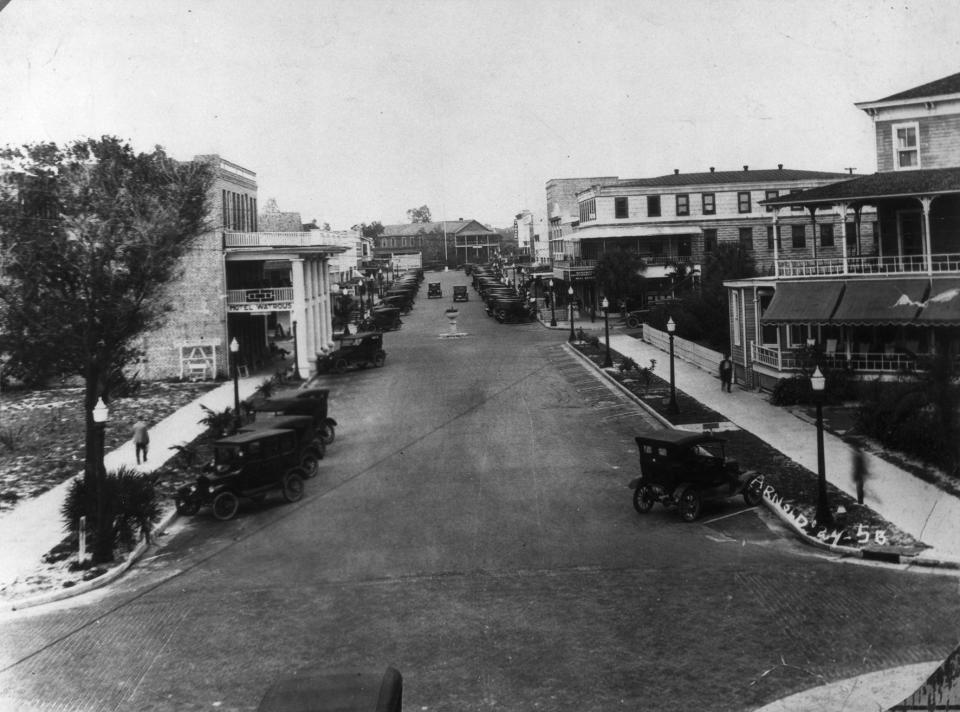
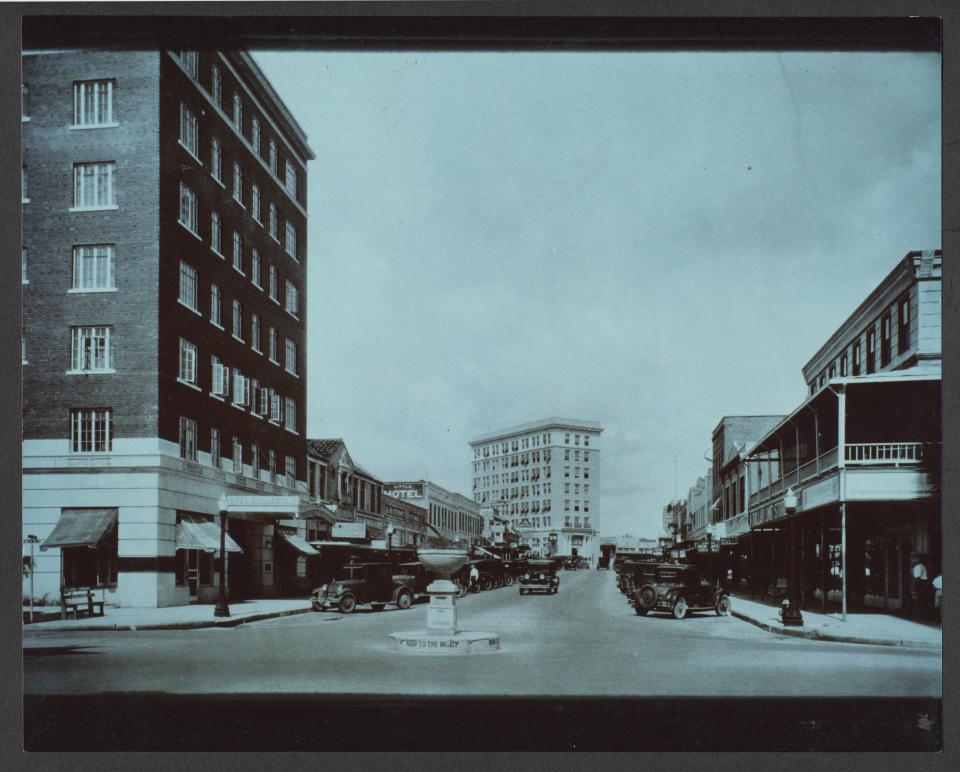
In 1920 he was elected justice of the peace for the 7th District of Manatee County, a position he maintained when Sarasota County was formed. He held the position during his first years as mayor and resigned in 1925 as his mayoral duties began taking too much time.
Bacon traveled throughout the state learning the good and bad points in the government of other cities, and always boosting Sarasota.
On one such trip, the first-ever “City Chiefs” meeting held in Jacksonville, Mayor Bacon addressed the assemblage of Florida Mayors assuring that he was foursquare behind the notion that there was “no North Florida, no West Florida, no South Florida, no East Coast – but one Florida,” all joining together to assist the Florida Development Board to raise a statewide fund for the purpose of advertising Florida to the world.
During one election campaign, Bacon promised to “endeavor to give the City a clean business-like administration and solicit the advice and counsel of the citizens on any important matters.”
Bacon reduced the tax rate from 21 to 12 mills and at the same time the city paid off its debt.
The only female mayor in Florida, Mrs. H.M. Strickland of Live Oak, was also in attendance. According to the Herald, her presence “made the occasion more enjoyable. She is said to be a woman of strong personality, of the brunette type, very attractive, and proved to be a regular good fellow," a description that would not make it into print today.
Bacon often said he did not want politics to become involved in city government, a sentiment shared by most of Sarasota’s civic leaders.
In 1923, the mayor/real estate entrepreneur voted with the majority when the Realtors Association was formed. Placed on the board of directors, one of the main purposes of the Association was to eliminate “curb-stone” traders who would come into a community for a few days or weeks and enter real estate transactions in which the buyer has no redress against fraudulent or misleading representations. It was noted that California and Oregon rid themselves of disreputable real estate agents.
Real History With Jeff LaHurd: Beloved by many, Charles Ringling left big mark on Sarasota
Real History With Jeff LaHurd: The bohemian brass band that entertained Sarasota
(The plan was probably not a 100% success, as Sarasota’s first real estate man, A.B. Edwards, recalled the “binder boys” of the Knickerbocker Army sleeping in their cars and at the train station, waiting for a passerby who wanted to strike it rich.)
On his own managerial style, Bacon said “It is my belief that if the men who head departments are given full charge of their organization with hiring and firing privileges better conditions will exist than if one man should take full charge of everything. ... It is therefore my policy to place the most experienced man available in full charge of each city department.”
In 1926 Mayor Bacon decided to campaign for the state Legislature while maintaining his mayoral duties. Given his experience and the appreciation of the citizens of Sarasota, he was a shoo-in. He was backed by the Herald, which recounted his many accomplishments.
Bacon promised he “could represent the county’s interest in an advantageous manner and would have the co-operation of the people of the city and Sarasota County as a whole.”
Prior to the election, in an ongoing series called Builders of Sarasota, the Herald featured a pen and ink drawing of Bacon and reported among his accomplishments that he had “improved a number of lots by building homes on them, developed sub-divisions in Phillippi Heights, Highland Crest, Mira Mar and Elysin.”
The paper reported that he loved to hunt and fish. And to bolster his chances for a legislative seat reminded, “His administration as mayor of this city covers a period which will always stand out as being marked by some of the most significant events in the history of Sarasota.”
He ran unopposed.
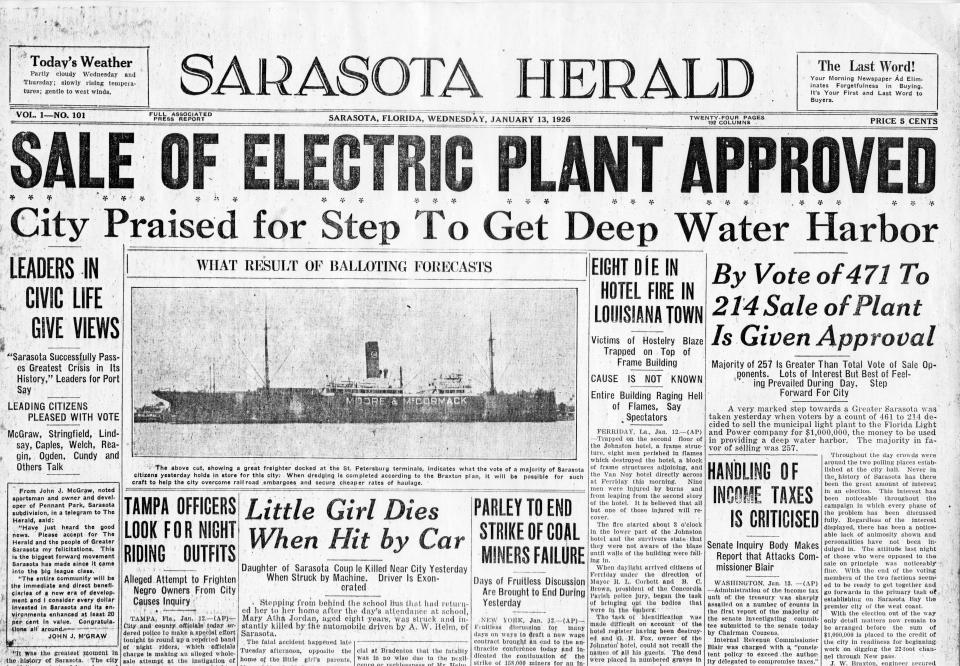
There were failures during his long tenure, some significant. As with most of the city’s movers and shakers, he jumped on the bandwagon, and lent his voice to the movement to sell the municipal electric plant for $1,000,000. The money was used to finance a deep-water port to attract ocean-going vessels, like in Jacksonville and Miami. The concept was bolstered by the railway embargo which prevented the arrival of building materials necessary for the continuation of construction projects in the city.
The port project quickly proved to be a failure. The accommodating channel leading to Payne Terminal at 10th Street quickly filled back in as many long-time residents, familiar with the ebb and flow of the tides, prophesied it would. However, some good came of the plan, as the dredge was used to create today’s popular City Island.
Trusting the good times would continue to roll on, the other miscue involved the drive to expand the city limits, which became an obsession for the progressives, Bacon included.
Sarasota’s land boom, still in full swing, needed more territory for development to continue. Therefore, it was decided to expand the city limits to 64 square miles, “the size of a real city.”
The Herald reported that the old city limits of approximately ten square miles had begun to cramp progress.
When the bill passed, Bacon said he was “Delighted beyond expression.” He was reported to have worked on the expansion for four years, expressing that “It is something that means the welfare of everybody.”
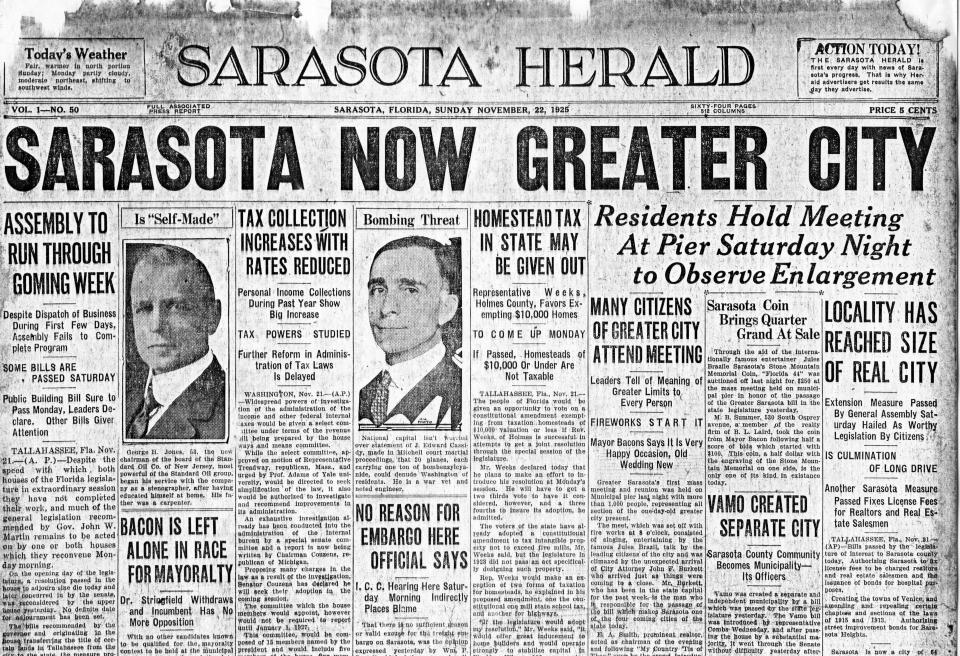
An interesting analogy was made by Willis B. Powell – general secretary of the Sarasota Chamber of Commerce – who likened it to wearing a perfect 36-inch pair of trousers. “Now our movements are not cramped in any direction. We can now loosen our belts and expand.”
The headline in the Nov. 22, 1925, Herald proudly read “SARASOTA NOW A GREATER CITY.”
Then came the bust, and local joy was quickly diminished.
After the crash, the city contracted Powell’s belt to “a more appropriate” 17 square miles, and even that diminished area was difficult to manage for a cash-strapped government.
Having ridden the crest of good times into the bust of the Great Depression, Bacon retired from politics to devote himself to his real estate business.
On Oct. 23, 1958, after a short illness, the man who was at the helm during Sarasota’s transformation passed away at Sarasota Memorial Hospital.
This article originally appeared on Sarasota Herald-Tribune: Sarasota History: City of Sarasota grew under Mayor Everett Bacon

